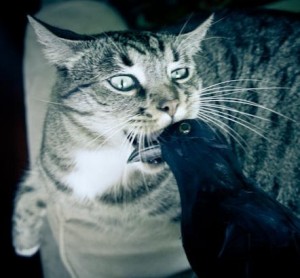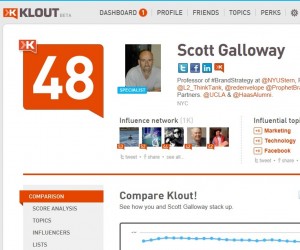 I hit the Klout jackpot this week. No, my Klout score of 40 isn’t suddenly up. Klout’s Marketing Manager Megan Berry personally left an incredibly insightful comment on my blog. Her comment isn’t gold to me because of the ego boost (O.K., maybe a little). It’s gold because it plainly illustrates the fallacy of Klout’s claim to be “the standard for influence.” Here’s how Berry summarized how Klout scores work:
I hit the Klout jackpot this week. No, my Klout score of 40 isn’t suddenly up. Klout’s Marketing Manager Megan Berry personally left an incredibly insightful comment on my blog. Her comment isn’t gold to me because of the ego boost (O.K., maybe a little). It’s gold because it plainly illustrates the fallacy of Klout’s claim to be “the standard for influence.” Here’s how Berry summarized how Klout scores work:
“1. Influence isn’t about you, it’s about your audience. We believe influence is the ability to drive action. You can tweet, post, blog, and be witty and insightful to your heart’s content, but influence begins when someone takes action on your content. This could be retweeting, commenting, liking, sharing, responding, or doing a handstand of joy (the latter is harder to measure). In reality, you have your audience and connections to thank for your influence. 2. Everyone (and anyone) can help your Klout. Your grandmother liking your Facebook status updates? That’s Klout. Your friend from high school congratulating you on your recent job change? That’s Klout. Your network commenting and discussing your latest blog post? That’s Klout. Whenever someone is influenced by you (and we can measure that), it helps your Klout Score.
“3. Yes, quality and breadth matter. All things being equal, having Barack Obama react to your content means more than if I do. All things being equal, having more people respond to your content raises your Score. The Klout Score is a combination of all of these factors: the number of people you influence, how much you influence them and how influential they are.”
 As a communicator with a background in changing people’s ideas and behaviors, her explanation blew me away!
As a communicator with a background in changing people’s ideas and behaviors, her explanation blew me away!
First of all, from a big picture perspective, I suspect Klout and its perk-pushing commercial customers envision social networks very differently from me. As I’ve written about many times, social networks are enabling swarms, self-organizing communities, to form around a common interest and fuel mass collaboration (a disruptive technology shift for the field of communications and just about every other business function). Klout and its commercial customers, however, seem to see social networks as just another communications channel for distributing messages.
More specifically, here’s the problem I have with Berry’s logic:
Klout measures influence by output, rather than outgrowths or outcomes. The examples Berry cite demonstrating your influence in the eyes of Klout—people “retweeting, commenting, liking, sharing, responding” to your content—are all outputs and have no relationship to whether your target audience received your message (outgrowth) and acted upon it in the way you wanted (outcome). To Berry’s credit, she does admit it’s hard to measure whether somebody does a handstand of joy after reading your content. But just because measuring outgrowths and outcomes is hard, doesn’t elevate the importance of outputs. After all, should people who tweet or post Facebook updates all day at work have high Klout? Or does that really diminish their reputation and influence?
Information alone does not change ideas or influence action. The examples Berry cite demonstrating your influence in the eyes of Klout—people “retweeting, commenting, liking, sharing, responding” to your content—also have little impact on changing ideas or influencing action, especially if your desired outcome costs a lot of money or is high risk. To effect meaningful change, your messages need to give people a sense of self efficacy or invoke social pressure/community norms among other things. In other words, you need a passionate swarm united around a common interest. The examples Berry sites—“your grandmother liking your Facebook status” or “your friend from high school congratulating you on your recent job change”—have nothing to do with this.
Klout doesn’t consider context and passion. Berry says President Obama reacting to your content means more than her reaction, implying interacting with people with high Klout raises your own. Klout, however, doesn’t seem to measure how relevant your message is to your audience. President Obama couldn’t influence me on hiring a chauffeur (like he would try) because I am not in the market for one. These days, context is king. For context to be meaningful from a business perspective, your messages need to have a business-relevant purpose that a swarm will rally around. In other words, no context + no passion = no influence.
Klout doesn’t consider the strong-tie phenomena. The New Yorker Staff Writer Malcolm Gladwell sparked a firestorm of criticism when he claimed—wrongly—revolutions won’t be tweeted because online communities have weak ties. While Gladwell underestimated the power of passion and common interest to bind strangers together online, his point about weak ties is still valid and applicable to Klout. Strong ties bind a college student sharing updates on Facebook with his small close-knit circle of friends. Weak ties, however, bind his roommate who shares on Facebook (or Twitter) with 500+ people he wouldn’t recognize if he passed on the street. Klout seems to treat all network ties as equal, thereby creating dubious influence measures. Obviously, the teenager with strong ties would have better luck convincing his online friends to use a designated driver before a night on the town. In other words, low or no passion + potential resistance = strong ties as a must.
As far as I am concerned, businesses who rely on Klout to disseminate messages (or products as Klout perks) risk wasting time on “provide and pray,” what a recent Harvard Business Review called the worst social media practice:
“Leaders and managers provide access to a social technology, and then pray that a community forms and that community interactions somehow lead to business value. In most cases, adoption never really materializes; communities may form, but their activity is not considered valuable to the organization. “
Axe hair jell anyone (see video below)?
What do you think of Klout scores? Do you think outputs, strong ties, passion, or purpose matter?





